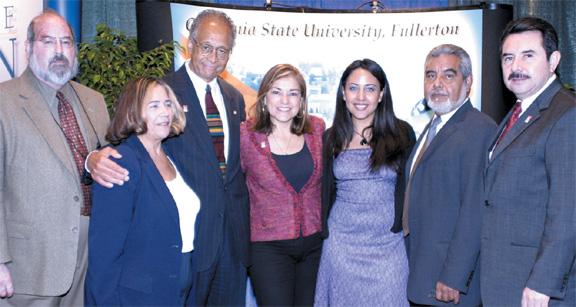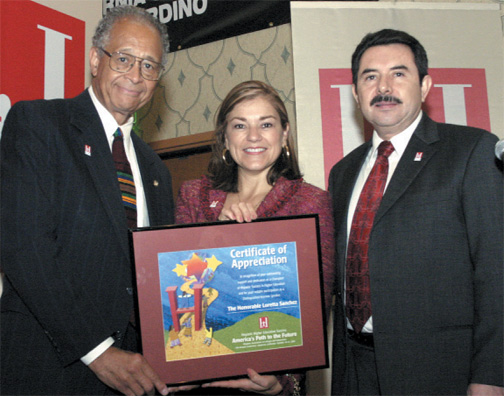|
From Hispanic Journal, November-December 2003 Closing the Hispanic college graduation gap
HACU rededicates Hispanic education advocacy efforts By Renee Haines By the close of this year’s 17th Annual Conference of the Hispanic Association of Colleges and Universities (HACU), leaders of campuses from New York to California, hit hard by the toughest higher education budget crunch in recent times, were ready to take their case to the public. “In this uncertain economy, there was consensus at every conference event that we must rededicate our efforts to convince Congress and the country to make closing the Hispanic college graduation gap a national priority. We must provide more support to those colleges and universities that educate the greatest concentrations of our Hispanic students,” HACU President and CEO Antonio R. Flores, Ph.D. said following the four-day conference in October in Anaheim, California. “The stakes are enormous because of the profound impact Hispanics will have on our country’s future. We cannot allow our country’s current economic constraints to preclude us from our best investment for a stronger economic future, an investment in the higher education success of our nation’s youngest and largest ethnic population,” Flores said.
U.S. Congresswoman Loretta Sanchez of California, a guest speaker at the national conference, put it more succinctly: “Where we go, so goes America.” Since its inception in 1986, HACU has relatively quickly become the nation’s voice for closing the Hispanic college graduation gap with a membership that has grown from 18 founding higher education institutions in a handful of states to more than 350 colleges and universities in 26 states and Puerto Rico. Collectively, these colleges and universities, located in every major U.S. Hispanic population center, serve more than two-thirds of all Hispanic higher education students. HACU has also become the nation’s sounding board and chief advocate for a Hispanic higher education community that has expanded in direct relation to the explosive growth in the Hispanic population. At the 17th Annual Conference, HACU heard urgent calls for increased federal funding for a category of higher education institutions known as Hispanic-Serving Institutions, or HSIs. HSIs, which serve the largest concentrations of Hispanic higher education students, by federal definition have a student enrollment that is at least 25 percent Hispanic. Because these institutions are located in or near every major U.S. Hispanic population center, their role has expanded to embrace every major initiative encouraging Latino students from kindergarten through high school to prepare for college. College enrollment is just one goal; successful retention efforts remain essential to increasing the actual numbers of Hispanics who graduate with a degree. “We have had great success at opening more doors to college for Hispanic students, but the end result must be keeping Hispanic students in college until their graduation. So HACU also directs its efforts to our college preparation programs, our undergraduate and graduate internship programs and to the daily advocacy work of our Washington, D.C., office,” said René González, HACU Director of Program Collaboratives at HACU national headquarters in San Antonio, Texas. Although Hispanic college enrollment has more than tripled in the past two decades, according to the 20th Anniversary Minorities in Higher Education Annual Status Report from the American Council on Education, Hispanics continue to suffer the lowest high school and college graduation rates of any major population group. U.S. Census Bureau figures released this year report that, for the population ages 25 and over as of March 2002, Hispanics had the lowest proportion of college graduates (11 percent), compared to 29 percent of non-Hispanic whites with college degrees and 17 percent of African-Americans. Hispanic high school dropout rates exceed 40 percent. HACU’s 17th Annual Conference provided a platform for HSIs to share their ideas for addressing both college access and retention. “Once a year, our Hispanic-serving colleges and universities come together to share what works best, and what can become models for other campuses to replicate for their students,” said HACU Director of Conferences Lilly Cardenas, who is already at work on HACU’s 18th Annual Conference in Miami in October 2004. At the 17th Annual Conference, California State University at Fullerton and Northeastern Illinois University shared the success of their partnerships with local school districts, using campus faculty and graduate students to actively engage children and their parents to aim early for college. The University of Minnesota shared the outcomes of its “U-Connects” program, which benefits multicultural one-to-one community mentoring initiatives. Valencia Community College in Florida and Los Angeles Valley College in California shared the details of campus programs measurably increasing Hispanic college retention rates. The University of South Florida presented its Project LASER (Linking Academic Scholars to Educational Resources) success story. A major topic of conference workshops was how to share limited grant resources for Hispanic higher education. HACU’s Washington, D.C., offices are where the daily work of winning new federal support for Hispanic higher education resumed immediately following the conference with a mandate from conference participants to keep Hispanic higher education funding a top national priority. HSIs receive only half the federal funding per student, on average, accorded to every other degree-granting institution. Yet, despite record annual federal funding increases HACU has won for HSIs in each of the past several years, HSIs are a long way from federal funding parity with non-HSIs. “With nearly every state already experiencing or now projecting state budget cutbacks for higher education, the Hispanic higher education community will fall even further behind if we do not advocate for substantial new federal support,” said HACU Executive Director of Legislative Affairs Luis Maldonado. “HACU’s biggest asset is the grass-roots leadership of our member and partner campuses, who present compelling testimony each year before Congress about the huge costs to our country implicit in not adequately funding these important institutions.” Hispanics already make up one of every three new workers joining the U.S. laborforce, and within the next few years will make up one of every two new workers joining the U.S. workforce, according to U.S. Department of Labor projections. A focus on the link between Hispanic higher education and the nation’s economic future is guiding plans now underway for HACU’s 2004 National Capitol Forum on Hispanic Higher Education, scheduled March 28-31, 2004, in Washington, D.C. Grass-roots advocacy is a key component to these annual forums. Hispanic higher education leaders meet personally with the leadership of Congress during annual Visits to Capitol Hill during each year’s Capitol Forum. “It can be very persuasive when the presidents of our colleges and universities personally visit the Washington, D.C., offices of their home districts’ senators and representatives and say, ‘I am here as your constituent. This is about the future of our state. Will you help our students?’” said HACU Vice President of Government Relations Gumecindo Salas. “It’s even more powerful when students themselves can meet their congressmen and women to make the case in person.” HACU’s best known advocate is HACU President and CEO Antonio Flores, who has championed Hispanic higher education needs before Congress and dozens of public forums in the United States and abroad, winning numerous national awards and international recognition in the process. Under his direction, HACU now administers several scholarship programs that have paved the way for a college diploma for hundreds of Hispanic students. The HACU National Internship Program, which provides paid internships at participating government agencies and corporate offices throughout the country, has become the largest Hispanic student internship program in the country. A major thrust of HACU’s programs is not only to close the college graduation gap, but to close that gap specifically in professions demanding advanced degrees where Hispanics remain historically underrepresented. González’ Office of Program Collaboratives, for example, is overseeing projects to increase the ranks of underrepresented Hispanic graduates in science, technology, engineering and mathematics. HACU is also leading efforts to train the next generation of researchers and faculty in the fast-growing health sciences sector, where Hispanics also are underrepresented. HACU has enlisted the help of outside resources through more than 30 formal partnership agreements with leading corporations and government agencies, which in many cases have led to new funding resources for member colleges and universities. “Every one of HACU’s initiatives and partnerships is aimed at addressing the need to equip our colleges and universities with the resources they must have to increase the ranks of Hispanic college graduates. It is an enormous challenge, which is why our association is proactive on so many fronts, including our efforts to ease the way for Hispanic students who do obtain their undergraduate degrees to go on to obtain their master’s, doctoral and professional degrees,” Flores said. “What events such as our 17th Annual Conference provide is the inspiration from so many committed educators, students, partners and supporters who are joined in the effort to close the Hispanic college gap. Together, we are making a difference.” |






